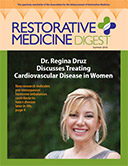Most heart failure patients have a history of hypertension.1 In fact, uncontrolled, chronically elevated blood pressure is the most common contributory factor to a host of complications, known collectively as hypertensive heart disease (HHD).2 The global prevalence of HHD increased by close to 138% between 1990 (7.82 million cases) and 2019 (19.6 million cases).3 This increase may be due in part to the revised diagnostic criteria for high blood pressure that were published in 2017,4 but hypertension remains the leading modifiable risk factor for cardiovascular disease and premature death worldwide.5 It is responsible for approximately 10 million deaths annually and is, therefore, a serious global public health issue.6
Modifiable risk factors for high blood pressure include being overweight, poor diet, excessive salt intake, smoking, high alcohol intake, and lack of physical exercise. Nonmodifiable risk factors include age, genetic predisposition, ethnicity, and some comorbid conditions that may have modifiable contributory factors, such as diabetes or kidney disease.7,8
Over time, increased hemodynamic stress on the heart from high blood pressure leads to the compensatory development of left ventricular hypertrophy (LVH). LVH, along with diffuse interstitial fibrosis, is one of the earliest signs of HHD. The list of further complications that can result from HHD is extensive, and includes ventricular arrhythmias, atrial fibrillation, heart valve disease, acute aortic syndromes, chronic kidney disease, myocardial ischemia, vascular dementia, heart failure, sudden cardiac arrest, and death.9,10 LVH with sustained hemodynamic stress is a leading cause of left-sided heart failure, a progressive syndrome that develops when the heart’s compensatory mechanisms, which affect its structure and function, can no longer meet the body’s metabolic needs.
Heart failure can be acute or chronic.11 Signs and symptoms may develop gradually or suddenly and include dyspnea with activity or when lying down; fatigue and weakness; peripheral edema; and jugular vein distention.12,13 It is important to note that sex-based differences in heart failure pathogenesis, risk factors, and responses to therapy are known, but not fully elucidated because women continue to be underrepresented in most cardiovascular studies.14 Heart failure may be diastolic (with preserved ejection fraction), systolic (with reduced ejection fraction), or a combination of both. Diastolic heart failure refers to the heart’s inability to optimally relax between beats, while systolic heart failure means the heart does not optimally contract during each heartbeat.15
The mechanisms by which hypertension impacts the pathogenesis of heart failure are not completely understood, but they may differ between heart failure with reduced ejection fraction and heart failure with preserved ejection fraction. In general, understanding of heart failure pathophysiology centers on the model of chronically elevated blood pressure leading to LVH and diastolic dysfunction, which cause myocardial rigidity to the extent that the myocardium can no longer effectively function in response to changes in preload, afterload, and sympathetic tone.16 Emerging evidence suggests that heart failure with preserved ejection fraction, which is characterized by abnormalities in the relationship between diastolic pressure and volume, may be due to systemic proinflammatory changes that are secondary to certain comorbid conditions, including hypertension. Signs and symptoms of heart failure with preserved ejection fraction can overlap with those of systolic heart failure, but diastolic heart failure is a more heterogeneous condition. Addressing systemic hypertension is key to managing both types of heart failure, but pharmacologic treatments used for systolic heart failure are not as successful in the treatment of diastolic heart failure and have not shown definitive benefit against mortality.17
More research is needed on possible subgroup phenotypes within heart failure patients, especially for those presenting with diastolic heart failure, and on the efficacy of non-pharmacological and lifestyle medicines for the management of high blood pressure.
Want to learn more about heart failure and functional medicine treatments? Decker Weiss, NMD and Regina Druz, MD are cardiology experts, and both will be sharing clinical protocols for heart failure at the Restorative Medicine Certification in Cardiology Principles program.
References
- https://www.sciencedirect.com/science/article/pii/S2213177917303177
- https://www.ahajournals.org/doi/full/10.1161/CIRCULATIONAHA.108.845792
- https://link.springer.com/article/10.1186/s12889-022-13271-0
- https://www.thelancet.com/journals/lancet/article/PIIS0140-6736(16)31919-5/fulltext
- https://www.nature.com/articles/s41581-019-0244-2
- https://world-heart-federation.org/what-we-do/hypertension/
- https://www.ahajournals.org/doi/full/10.1161/CIRCHEARTFAILURE.119.006472
- https://www.ahajournals.org/doi/full/10.1161/HYPERTENSIONAHA.118.12572
- https://www.ncbi.nlm.nih.gov/pmc/articles/PMC6392834/
- https://www.ahajournals.org/doi/full/10.1161/HYPERTENSIONAHA.119.14240
- https://www.nature.com/articles/s41572-020-0151-7
- https://onlinelibrary.wiley.com/doi/full/10.1002/ehf2.12555
- https://pubmed.ncbi.nlm.nih.gov/33605000/
- https://pubmed.ncbi.nlm.nih.gov/30051405/
- https://www.jacc.org/doi/abs/10.1016/j.jacc.2019.09.063
- https://www.nature.com/articles/s41440-022-01158-x#article-info
- https://pubmed.ncbi.nlm.nih.gov/28233237/
